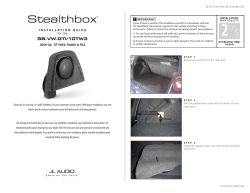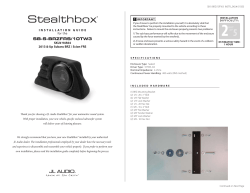
How to Set the TSC/AIC EVM to Record and Playback
Application Report SLAA233 – December 2004 How to Set the TSC/AIC EVM to Record and Playback Audio or Other Sound Through a PC Wendy X. Fang................................................................................................................. DAP Group ABSTRACT Record and playback audio, sound, or voice on a TI touch screen controller (TSC) or audio codec (AIC) EVM system by means of the associated software running on a PC system. The PC and EVM are connected using a USB cable. This application report gives an example to demonstrate how to do this through a Windows XP™ PC system. The block diagram and connection are shown in Figure 1. Audio/Sound Input Devices Such as Microphone PC USB Cable TI TSC/AIC EVM Audio/Sound Output Devices Such as Headphone, Speakers Key Board/Mouse Figure 1. Block Diagram TI has several evaluation modules (EVMs) that can be connected to a PC system and controlled through the PC software. Such EVMs include the TSC2301EVM, TSC2100EVM, TSC2101EVM, TLV320AIC26EVM, and the TLV320AIC28EVM. Follow the relevant User's Guide for the specific TSC or AIC device of interest to set up and install the hardware and software. After successful software installation, connect the USB cable between the PC and the TI DSP and check the Sounds and Audio Devices for the installed EVM from the PC Control Panel. The properties for audio sound recording and playback should be similar that shown in Figure 2. Windows XP is a trademark of Microsoft Corporation. Microsoft is a registered trademark of Microsoft Corporation. SLAA233 – December 2004 How to Set the TSC/AIC EVM to Record and Playback Audio or Other Sound Through a PC 1 www.ti.com Figure 2. Sounds and Audio Devices Properties Start the EVM software and view the first tab of the EVM software GUI. For example, start the TLV320AIC28 (or AIC28 for short) EVM software, and the GUI window shown in Figure 3 appears. Figure 3. GUI Window: Data Acquisition Tab 2 How to Set the TSC/AIC EVM to Record and Playback Audio or Other Sound Through a PC SLAA233 – December 2004 www.ti.com On the software GUI window, click on the Audio 1 tab to see the audio control tab options shown in Figure 4. Figure 4. GUI Window: Audio 1 Tab Example The EVM audio DAC output drives may not be powered up in many of the TSC/AIC EVM systems, giving you the option to evaluate and test different power-up sequences for best performance and pop reduction. To playback any audio on the EVM, it is necessary to power up and unmute the audio outputs. In this AIC28 EVM example, uncheck the SP1 and SP2 check boxes shown under Power Down; also unmute SP1, SP2, and the left and right DACs. The Audio 1 control tab should look like Figure 5. SLAA233 – December 2004 How to Set the TSC/AIC EVM to Record and Playback Audio or Other Sound Through a PC 3 www.ti.com Figure 5. Audio 1 Control Tab: SP1, SP2, and DACs Unmuted With these settings, you are ready to perform audio record and playback of the EVM using the controls of the PC. To Record: (1) Open a sound record utility on the PC, such as Sound Recorder from Windows XP as shown in Figure 6. Figure 6. GUI Window: Sound – Sound Recorder (2) Using the File/Properties menus, open a window for Properties for Sound, as shown in Figure 7. 4 How to Set the TSC/AIC EVM to Record and Playback Audio or Other Sound Through a PC SLAA233 – December 2004 www.ti.com Figure 7. GUI Window: Properties for Sound (3) Click on the Convert Now… button in the Properties for Sound window, to open another window for Sound Selection, as shown in Figure 8. Figure 8. GUI Window: Sound Selection SLAA233 – December 2004 How to Set the TSC/AIC EVM to Record and Playback Audio or Other Sound Through a PC 5 www.ti.com (4) For mono audio ADC devices, such as TSC2100 or AIC28, set the Attributes to: 44.100 kHz, 16 bit, Mono, as shown in Figure 8. For stereo audio ADC devices, such as TSC2301, set the Attributes to: 44.100 kHz, 16 bit, Stereo. (5) Click on the OK button to close the Sound Selection window. (6) Click on the OK button again to close the Properties for Sound window. (7) Click the Record button (Red dot) on the Sound – Sound Recorder window to start the recording. Speak through the onboard EVM MIC, or external MIC, and verify that the sound recorder starts to record the sound, as shown in Figure 9. Figure 9. GUI Window: Sound Recorder Session (8) When done, click the Stop button to stop recording. Figure 10 displays the Sound Recorder after a microphone recording. Figure 10. GUI Window: Sound Recorder Session Finish 6 How to Set the TSC/AIC EVM to Record and Playback Audio or Other Sound Through a PC SLAA233 – December 2004 www.ti.com (9) Click on the Play button to play back the recorded sound. Verify the recorded sound from the headphone (J7) connection on the (AIC28) EVM. You may also save the recorded sound to a *.wav file on the PC by choosing File/Save from the menu of the Sound Recorder. The *.wav file may be played through other software, such as the Microsoft® Windows Media Player, as described in the following section. Playback of Recordings: There are several ways to play back recorded audio signals, music on a CD, or other sound and audio signals. As discussed previously, the recorded sound can be played using the PC sound recorder feature. Also, you can open the Windows Media Player from your PC, as shown in Figure 11: Figure 11. GUI: Windows Media Player SLAA233 – December 2004 How to Set the TSC/AIC EVM to Record and Playback Audio or Other Sound Through a PC 7 www.ti.com Use the TSC/AIC EVM as a normal audio output device. Launch the Windows Media Player on the PC, and select the saved music/sound/voice files, CDs, and other audio signals from the PC, or from a Web site by clicking on the Media Guide of the menu on the left side of the Windows Media Player window. Users can also go to the TI EVM’s GUI to set up and control the audio input/output features of the corresponding device. Figure 5 shows the user-selectable options on the Audio 1 tab of the AIC28EVM GUI. Other options are available on the Audio 2 tab and the Audio Effects Filters tab. The corresponding TSC/AIC device data sheet also provides the details of these audio features and functions. Reference Material Data Sheet Literature Number Evaluation Module User's Guide Literature Number TSC2100 SLAS378 TSC2100EVM SLAU100 TSC2101 SLAS392 TSC2101EVM SLAU112 TSC2301 SLAS371 TSC2301EVM SLAU098 TLV320AIC26 SLAS412 TLV320AIC26EVM SLAU128 TLV320AIC28 SLAS418 TLV320AIC28EVM SLAU127 Device Trademarks and Copyright Information Screen shots reprinted by permission from Microsoft Corporation. The names of actual companies and products mentioned in this application report may be trademarks of their respective companies. 8 How to Set the TSC/AIC EVM to Record and Playback Audio or Other Sound Through a PC SLAA233 – December 2004 IMPORTANT NOTICE Texas Instruments Incorporated and its subsidiaries (TI) reserve the right to make corrections, modifications, enhancements, improvements, and other changes to its products and services at any time and to discontinue any product or service without notice. Customers should obtain the latest relevant information before placing orders and should verify that such information is current and complete. All products are sold subject to TI’s terms and conditions of sale supplied at the time of order acknowledgment. TI warrants performance of its hardware products to the specifications applicable at the time of sale in accordance with TI’s standard warranty. Testing and other quality control techniques are used to the extent TI deems necessary to support this warranty. Except where mandated by government requirements, testing of all parameters of each product is not necessarily performed. TI assumes no liability for applications assistance or customer product design. Customers are responsible for their products and applications using TI components. To minimize the risks associated with customer products and applications, customers should provide adequate design and operating safeguards. TI does not warrant or represent that any license, either express or implied, is granted under any TI patent right, copyright, mask work right, or other TI intellectual property right relating to any combination, machine, or process in which TI products or services are used. Information published by TI regarding third-party products or services does not constitute a license from TI to use such products or services or a warranty or endorsement thereof. Use of such information may require a license from a third party under the patents or other intellectual property of the third party, or a license from TI under the patents or other intellectual property of TI. Reproduction of information in TI data books or data sheets is permissible only if reproduction is without alteration and is accompanied by all associated warranties, conditions, limitations, and notices. Reproduction of this information with alteration is an unfair and deceptive business practice. TI is not responsible or liable for such altered documentation. Resale of TI products or services with statements different from or beyond the parameters stated by TI for that product or service voids all express and any implied warranties for the associated TI product or service and is an unfair and deceptive business practice. TI is not responsible or liable for any such statements. Following are URLs where you can obtain information on other Texas Instruments products and application solutions: Products Applications Amplifiers amplifier.ti.com Audio www.ti.com/audio Data Converters dataconverter.ti.com Automotive www.ti.com/automotive DSP dsp.ti.com Broadband www.ti.com/broadband Interface interface.ti.com Digital Control www.ti.com/digitalcontrol Logic logic.ti.com Military www.ti.com/military Power Mgmt power.ti.com Optical Networking www.ti.com/opticalnetwork Microcontrollers microcontroller.ti.com Security www.ti.com/security Telephony www.ti.com/telephony Video & Imaging www.ti.com/video Wireless www.ti.com/wireless Mailing Address: Texas Instruments Post Office Box 655303 Dallas, Texas 75265 Copyright 2004, Texas Instruments Incorporated
© Copyright 2025












